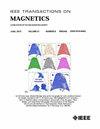Numerical Analysis for Negative Discharge Under High-Frequency Pulsed Voltage
IF 2.1
3区 工程技术
Q3 ENGINEERING, ELECTRICAL & ELECTRONIC
引用次数: 0
Abstract
The increase in renewable energy and the development of silicon carbide (SiC) and gallium nitride (GaN) power switches have led to higher voltage magnitudes, slew rates, and switching frequencies, imposing greater electric stress on insulating materials. However, it is hard to recognize the partial discharge (PD) signal from background noise due to electromagnetic interference when diagnosing electrical equipment with high switching frequency. Therefore, we numerically analyzed negative corona discharge under a superposition of direct current (dc) and pulsewidth modulation (PWM) voltage, with a switching frequency of 80 kHz in a needle-plane geometry varying rising times of 100, 200, and 500 ns. The analysis model was coupled with Poisson’s equation and the drift-diffusion model. We considered three types of charge carriers—electrons, positive ions, and negative ions—and the generation and loss of each charge carrier. The discharge current was calculated from Poynting’s theorem. The discharge current pulses were regularly sustained, like the Trichel pulses in the previous research. However, the periods between pulses and the magnitude of the pulses changed depending on the applied voltage and rising time. With the increase in rising time, both the current pulse peak value and the pulse period decreased, affecting the charge distribution, especially for the ionization region and negative ions.高频脉冲电压下负放电的数值分析
可再生能源的增加以及碳化硅(SiC)和氮化镓(GaN)功率开关的发展导致了更高的电压幅度、转换速率和开关频率,对绝缘材料施加了更大的电应力。然而,在对高开关频率电气设备进行诊断时,由于电磁干扰,很难从背景噪声中识别局部放电信号。因此,我们数值分析了直流(dc)和脉宽调制(PWM)电压叠加下的负电晕放电,开关频率为80 kHz,在针平面几何结构中上升时间为100、200和500 ns。分析模型与泊松方程和漂移扩散模型相结合。我们考虑了三种类型的电荷载体——电子、正离子和负离子——以及每种电荷载体的产生和损失。放电电流由波印亭定理计算。放电电流脉冲有规律地持续,与之前研究的Trichel脉冲相同。然而,脉冲之间的周期和脉冲的大小取决于施加的电压和上升时间。随着上升时间的增加,电流脉冲峰值和脉冲周期均减小,影响电荷分布,尤其是电离区和负离子的电荷分布。
本文章由计算机程序翻译,如有差异,请以英文原文为准。
求助全文
约1分钟内获得全文
求助全文
来源期刊

IEEE Transactions on Magnetics
工程技术-工程:电子与电气
CiteScore
4.00
自引率
14.30%
发文量
565
审稿时长
4.1 months
期刊介绍:
Science and technology related to the basic physics and engineering of magnetism, magnetic materials, applied magnetics, magnetic devices, and magnetic data storage. The IEEE Transactions on Magnetics publishes scholarly articles of archival value as well as tutorial expositions and critical reviews of classical subjects and topics of current interest.
 求助内容:
求助内容: 应助结果提醒方式:
应助结果提醒方式:


